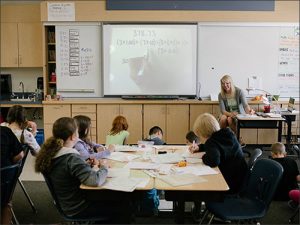The K-12 Marketplace: What to Look for in 2016

The next year is likely to bring notable changes and churn in the K-12 market, as districts take up new forms of technology and explore new ways of delivering content and instruction, and as historic shifts in federal policy take hold.
School leaders are becoming increasingly keen on new technologies that can engage students, and assess their academic strengths and shortcomings quickly–often in combination. Ed-tech providers of all sizes are scrambling to accommodate them.
Meanwhile, schools’ priorities and needs are being shaped by big changes in education policy. Over the past year and a half, for instance, the Federal Communications Commission has promised billions in new spending to help schools improve broadband capabilities through the E-rate program.
And just this month, President Obama signed into law the Every Student Succeeds Act, which replaces No Child Left Behind and has huge implications for state and local testing, school turnarounds, special education, English-language learning, teacher quality–you name it.
Here’s our list of things to watch for in the K-12 market in 2016. The topics are of both the macro and micro variety. I’ve compiled it with contributions from fellow industry and innovation reporter Michele Molnar and our lead ed-tech reporter, Ben Herold.
1. The Dawn of ESSA
Soon to become the most omnipresent acronym in the education world, the law marks the biggest remaking of federal school policy in more than a decade–and it carries potentially enormous shifts for companies involved in testing, intervention, teacher training, and myriad other areas.
The new law retains some of NCLB’s core testing mandates, but also gives states and districts new powers to revise their accountability measures. Districts will have new flexibility in crafting overhauls of struggling schools. And states will for the first time have to include some non-academic factors–such as measures of student engagement, or school climate–in their accountability systems.
2. The Growth and Evolution of “Open” Education Resources
Over the past few years, a growing number of districts have begun using open educational resources–materials created under a license that allows for their free use, sharing, and repurposing–as an alternative to traditional commercial products. Look for the “open” take-up and experimentation to continue.
Districts are already tapping into major, online repositories of open resources, perhaps most notably EngageNY, which to date has offered English/language arts and math content, but is now being expanded to other academic subjects, and other needs—such as providing materials catering to English-language learners.
The Obama administration has also shown an interest in promoting open resources. It recently proposed a new regulation to require any intellectual property developed with grant funds from the department to be openly licensed.
3. New Uses of Assessments
School officials have shown an appetite for quick, useful assessments that can collect data on student learning in innovative ways. Embedding assessments in games is one such strategy (see Ben Herold’s story on GlassLab’s work in this area), and as districts’ interest in classroom-based assessment evolves, expect new frontiers to emerge.

4. Demands for Project-Based Learning
Districts have become increasingly focused on classroom tools that challenge students while also keeping them engaged academically, and promoting “deeper learning.” In schools, this means providing more opportunities for project-based learning. For others, the focus is trying to incorporate “maker-spaces” and similar approaches into their classrooms. In some cases, those efforts are ambitious–akin to creating “1-to-1” maker-space programs, though questions remain about the feasibility of those approaches.
A recent report on ed-tech trends released by the New Media Consortium and the Consortium for School Networking aptly summed up schools’ interests in this area as one focused on moving students from “consumers to creators.”
5. Investments in Tech Infrastructure
The FCC in 2014 and 2015 agreed to devote billions more in spending to the E-rate program, which supports connectivity in the nation’s schools and libraries.
A big chunk of that money will flow to support schools’ demands for internal Web connectivity, after what many K-12 officials said was years of neglect. Districts’ demands for technology in their federal applications are already changing significantly. For a detailed breakdown of business opportunities for K-12 providers in the E-rate 2.0, see Michele Molnar’s analysis in the newly launched EdWeek Market Brief.
6. Meeting the Needs of Diverse K-12 Populations
The number of English-language learners, particularly Latinos, in U.S. schools, has surged over the past two decades in the United States, and that trend is likely to continue, putting all kinds of new pressures on schools.
As a result, districts of all sizes are demanding that vendors produce instructional content and tools that are challenging, specific to academic subjects, and scaffolded to meet the needs of students whose English is at very different levels. Our newly published story in EdWeek Market Brief offers a detailed dissection of K-12 officials’ emerging needs in this area.
ELL resources are especially important in many U.S. districts where the Latino population is growing, but not yet at the point where K-12 leaders are willing to invest in hiring full-time language specialists. In those school systems, teachers and support staff need to develop ELL expertise–and they need the tools to help them do it.
7. Rising K-12 Demands for Research, and Useful Ed-Tech Evaluations
Districts are increasingly demanding proof of research or evidence before they invest in ed-tech, according to the feedback we hear from both the K-12 community and vendors. That can mean very different things.
Some school systems, most notably New York City’s iZone, are encouraging “short-cycle” evaluations that consider teachers’ classroom tech needs and apply clear, and independent, standards for reviewing products.
The Jefferson Education Accelerator, a commercial effort that creates a process for allowing vendors to have their products tested in K-12 districts, is also encouraging short-cycle evaluations, as well as more rigorous research for companies that are ready.
The bottom line is that ed-tech companies are well-advised to have plans in place for conducting research and fielding questions about the results, said Bart Epstein, CEO of the Jefferson Education Accelerator.
“There’s definitely an increasing amount of pressure from schools and teachers” to show product effectiveness, Epstein said in a recent interview. At the same time, “Quite a few companies aspire to do rigorous research,” but they aren’t sure where to start, he added. The JEA is one of the organizations trying to help them.
We’ve written in the past about district officials and school leaders becoming savvier and more organized in trying to judge the effectiveness of ed-tech products used in their schools. The nonprofit Digital Promise recently published a cheat-sheet designed to help K-12 officials judge the research and evaluations companies bring to the table.
8. Building Better Dashboards
Districts’ interest in learning dashboards–which allow educators to examine and connect data from a variety of sources–is not new. But districts are increasingly intent on securing dashboards that provide the metrics they want, are easy for teachers and others to use, and are compatible with a variety of commercial products.
The U.S. Department of Education’s recently released National Education Technology Plan, it’s worth noting, recently described improving schools’ use of learning or data dashboards as a priority. Ed Week will have a story breaking down district needs for these platforms, to be published over the next few weeks.
Obviously, this isn’t an all-inclusive list of prognostications. You no doubt have your own ideas. Let us know how you see the market shifting in 2016, and beyond.
Photo, upper right: Fourth grade teacher Kassie Hibbard leads a math lesson at Nelson Elementary School in the Bethel (Wash.) school district, which has adopted open educational resources. Ian C. Bates for Education Week.
Follow @EdWeekSCavanagh and @EdMarketBrief for the latest news on industry and innovation in education.

5 thoughts on “The K-12 Marketplace: What to Look for in 2016”